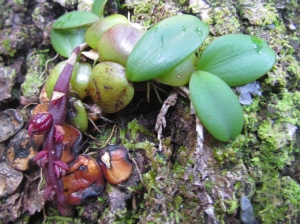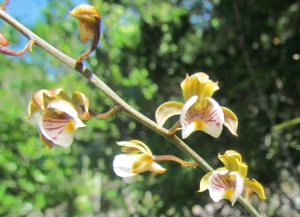Sainte Luce and Petriky
April 21, 2012 at 7:53 am Leave a comment
I just got back from round two of orchid data collection, which took place in Petriky. Now that I find myself with some free time, I’ll write a little bit about what life has been like over the last couple of weeks in the forests.
I spent my days in the forests navigating through densely packed vegetation and looking for orchids in every spot they might be: on the ground, on rocks, and on other plants. When I found a species I hadn’t seen yet, I recorded its GPS location, its habitat, and the number of individuals. Additionally, anytime I found a species in an especially large concentration, I would set up a 5m x 5m plot to survey it and all other species found in the plot. In this way, I got a list of species found in each forest and an estimate for the maximum possible density of each species in each forest. Using these maximum possible densities, I will be able to do a rough comparison between the forests to see if certain species are more common in one forest than in another.
In Sainte Luce, I found 23 species of orchids. In the literature, only 7 species have been reported there. Then in Petriky, I found 15 species, whereas only 3 species were previously reported there. Woop! Also, I noticed that a significantly higher percent of the species in Petriky are terrestrial than in Sainte Luce. I’m not sure why there’s such a difference. Petriky is overall drier than Sainte Luce, but I don’t imagine that being the reason for a higher number of terrestrial species there… I have quite a write-up ahead of me! And I haven’t even looked at the third forest, Mandena, yet.
Overall, the camping has been a fun experience. I especially enjoyed Sainte Luce. The campsite is well developed and and staffed. There was a covered concrete spot under which we put our tents, which helped us better stay dry inside our tents. There was a full-time cooking staff there put in place by QMM and consisting of two very nice women who cook the most delicious food I’ve eaten in all of Madagascar. Even the rice water was especially tasty. Also, there were flushing toilets!
The weather in Sainte Luce was rainy towards the end, so we wound up having to camp an extra day. The roads to Sainte Luce are already in bad shape, and when it’s rainy, it becomes impossible to travel there. Camping for an extra day wasn’t too bad, though — in fact, that meant three more extra delicious meals.
Petriky was a rougher experience. There was no covered campsite, so we camped out in the open, which meant we got a little bit wet. Even with rainflies, water tends to leak into tents. And it rained a lot, especially at night. Furthermore, there was no cooking staff in place, so we brought all of the food and dishes we would need and cooked for ourselves. I did a lot of dishes. This made me realize how it’s impossible to fully clean dishes… The only thing available with which to clean dishes is the tap water, which is brown and which my advisor said not to drink. It’s impossible to dry the dishes before eating off of them, so we inevitably wind up drinking the tap water. I think this is how it has been in general — I’ve been drinking Malagasy tap water without noticing due to the fact that I am eating off of plates cleaned with it. One cannot escape from the tap water! That explains why all the SIT students suffer from microbes at the beginning of the trip. I must be mostly adjusted by now, because consuming this water at Petriky did me no harm.
The toilet at Petriky was a hole in the ground, which is all good, but less luxurious than flushing toilets for sure. Mosquitoes were rampant. When I got bored one night, I rolled up my pant legs and counted — 18 bites! Also, I got pretty lonely during my time in Petriky. In Sainte Luce, the cooking staff ladies spoke some French, so I was able to communicate with them. Plus, I got along really well with the student, Marco, who went with me to Sainte Luce. In Petriky, however, the only people on site were the guards (who speak zero French and are all middle-aged men) and the two people I went with — a young female student and a middle-aged QMM botanist. These two people spoke French, but they were more content to speak in Malagasy. And when we did speak together in French, it was somehow very clear that we had little in common. I felt really disconnected from the world during those few days, so I was especially happy to get back to Fort Dauphin, where I am now.
The next step is a couple of days in Mandena (which is close to Fort Dauphin, so camping will not be necessary) and then the write up. Come this time next week, I’ll be mostly done with this project — and mostly done with this semester! But until then… I have some serious work to do.
Until next time! Here are some pictures of the orchids I’ve been looking at.
Bulbophyllum elliottii, Sainte Luce

Bulbophyllum cf humblotti, Sainte Luce

Angraecum eburneum var. xerophilum, Petriky

Lissochilus beravensis, Petriky

Entry filed under: Uncategorized. Tags: biodiversity, coursework, independent study project, littoral forest, Madagascar, orchids, photo, plants.
Trackback this post | Subscribe to the comments via RSS Feed